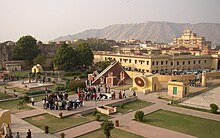This article's lead section may be too long. (December 2021) |




A Jantar Mantar (Hindustani pronunciation: [d͡ʒən̪t̪ər mən̪t̪ər]) is an assembly of stone-built astronomical instruments, designed to be used with the naked eye. There were five Jantar Mantars in India. All were built at the command of the Rajah Jai Singh II, who had a keen interest in mathematics, architecture and astronomy. The largest example is the equinoctial sundial belonging to Jaipur's assembly of instruments, consisting of a gigantic triangular gnomon with the hypotenuse parallel to the Earth's axis. On either side of the gnomon is a quadrant of a circle, parallel to the plane of the equator. The instrument can be used with an accuracy of about 20 seconds by a skilled observer to determine the time of day, and the declination of the Sun and the other heavenly bodies. It is the world's largest stone sundial, and is known as the Samrat Yantra.[1][2] The Jaipur Jantar Mantar is a UNESCO World Heritage Site.[3]
- ^ Smithsonian (2013). Timelines of Science. Penguin. p. 136. ISBN 978-1465414342.
- ^ Archaeological Survey of India, various authors, Nomination of The Jantar Mantar, Jaipur, for inclusion on World Heritage list, p.14 [1]
- ^ Unesco listing for Jantar Mantar accessed July 30 2021